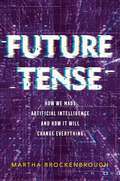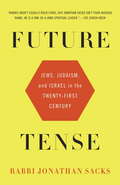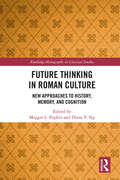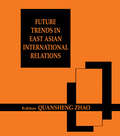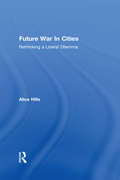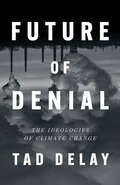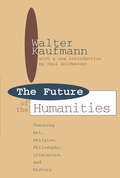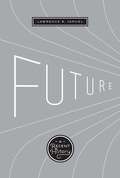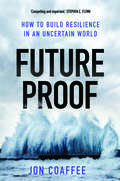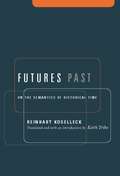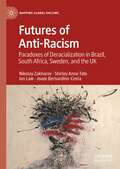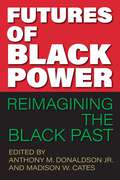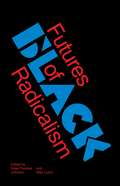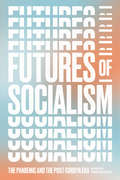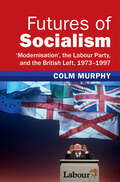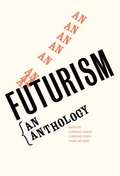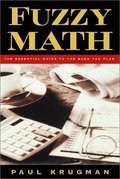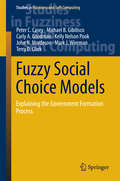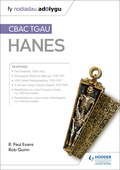- Table View
- List View
Future Tense: How We Made Artificial Intelligence—and How It Will Change Everything
by Martha BrockenbroughHuman history has always been shaped by technology, but AI is like no technology that has come before it. Unlike the wheel, combustion engines, or electricity, AI does the thing that humans do best: think. While AI hasn’t reproduced the marvelously complex human brain, it has been able to accomplish astonishing things. AI has defeated our players at games like chess, Go, and Jeopardy!. It’s learned to recognize objects and speech. It can create art and music. It’s even allowed grieving people to feel as though they were talking with their dead loved ones.On the flip side, it’s put innocent people in jail, manipulated the emotions of social media users, and tricked people into believing untrue things.In this non-fiction book for teens, acclaimed author and teacher Martha Brockenbrough guides readers through the development of this world-changing technology, exploring how AI has touched every corner of our world, including education, healthcare, work, politics, war, international relations, and even romance. This is essential reading for anyone who wants to understand how artificial intelligence got here, how to make the best use of it, and how we can expect it to transform our lives.
Future Tense: Jews, Judaism, and Israel in the Twenty-First Century
by Jonathan SacksOne of the most admired religious thinkers of our time issues a call for world Jewry to reject the self-fulfilling image of "a people alone in the world, surrounded by enemies" and to reclaim Judaism's original sense of purpose: as a partner with God and with those of other faiths in the never-ending struggle for freedom and social justice for all. We are in danger, says Rabbi Jonathan Sacks, of forgetting what Judaism's place is within the global project of humankind. During the last two thousand years, Jews have lived through persecutions that would have spelled the end of most nations, but they did not see anti-Semitism written into the fabric of the universe. They knew they existed for a purpose, and it was not for themselves alone. Rabbi Sacks believes that the Jewish people have lost their way, that they need to recommit themselves to the task of creating a just world in which the divine presence can dwell among us. Without compromising one iota of Jewish faith, Rabbi Sacks declares, Jews must stand alongside their friends--Christian, Muslim, Hindu, Sikh, Buddhist, and secular humanist--in defense of freedom against the enemies of freedom, in affirmation of life against those who desecrate life. And they should do this not to win friends or the admiration of others but because it is what a people of God is supposed to do. Rabbi Sacks's powerful message of tikkun olam--using Judaism as a blueprint for repairing an imperfect world--will resonate with people of all faiths.From the Hardcover edition.
Future Thinking in Roman Culture: New Approaches to History, Memory, and Cognition (Routledge Monographs in Classical Studies)
by Maggie L. Popkin Diana Y. NgFuture Thinking in Roman Culture is the first volume dedicated to the exploration of prospective memory and future thinking in the Roman world, integrating cutting edge research in cognitive sciences and theory with approaches to historiography, epigraphy, and material culture. This volume opens a new avenue of investigation for Roman memory studies in presenting multiple case studies of memory and commemoration as future-thinking phenomena. It breaks new ground by bringing classical studies into direct dialogue with recent research on cognitive processes of future thinking. The thematically linked but methodologically diverse contributions, all by leading scholars who have published significant work in memory studies of antiquity, both cultural and cognitive, make the volume well-suited for classical studies scholars and students seeking to explore cognitive science and philosophy of mind in ancient contexts, with special appeal to those sharing the growing interest in investigating Roman conceptions of futurity and time. The chapters all deliberately coalesce around the central theme of prospection and future thinking and their impact on our understanding of Roman ritual and religion, politics, and individual motivation and intention. This volume will be an invaluable resource to undergraduate and postgraduate students of classics, art history, archaeology, history, and religious studies, as well as scholars and students of memory studies, historical and cultural cognitive studies, psychology, and philosophy.
Future Trends in East Asian International Relations: Security, Politics, and Economics in the 21st Century
by Quansheng ZhaoThe world has undergone significant change since the end of the Cold War. One such development is that the Asia-Pacific has become increasingly prominent in international affairs. This comprehensive study provides a detailed understanding of key issues, actors and future trends in the region.
Future War In Cities: Rethinking a Liberal Dilemma
by Alice HillsThis book is the first full-length study of a key security issue confronting the west in the twenty-first century, urban military operations - as currently being undertaken by US and UK forces in Iraq. It relates military operations in cities to the wider study of conflict and security in an era of urbanisation, expeditionary warfare and new power
Future Weapons
by Kevin DockeryOn the battlefield, a soldier's best friends are his gun and his gear-because his life depends on them. But what will it take to fight and survive on the battlefields of tomorrow? What will those combat arenas consist of, and where will they be? And what will our nation's fighting men and women carry with them into battle? This is a compendium of the weapons of war that may accompany our soldiers in the near and far future, as well as an insightful look at the soldier, sailor, and airman of today and tomorrow. All manner of military hardware is covered, as well as information about cutting-edge technology that will become standard in weapons to come, the possibility of robotic soldiers, vehicles, protective armor, and the prospects of fighting a war in both space and cyberspace.
Future of Denial: The Ideologies of Climate Change
by Tad DeLay"Tad DeLay is one of the most important and disquieting theorists of consciousness and politics writing today. His work is indispensable."—China Miéville, author of OctoberCapitalism is an ecocidal engine constantly regenerating climate change denialThe age of denial is over, we are told. Yet emissions continue to rise while gimmicks, graft, and green- washing distract the public from the climate violence suffered by the vulnerable. This timely, interdisciplinary contribution to the environmental humanities draws on the latest climatology, the first shoots of an energy transition, critical theory, Earth&’s paleoclimate history, and trends in border violence to answer the most pressing question of our age: Why do we continue to squander the short time we have left?The symptoms suggest society&’s inability to adjust is profound. Near Portland, militias incapable of accepting that the world is warming respond to a wildfire by hunting for imaginary left-wing arsonists. Europe erects nets in the Aegean Sea to capture migrants fleeing drought and war. An airline claims to be carbon neutral thanks to bogus cheap offsets. Drone strikes hit people living along the aridity line. Yes, Exxon knew as early as the 1970s, but the fundamental physics of carbon dioxide warming the Earth was already understood before the American Civil War.Will capitalists ever voluntarily walk away from hundreds of trillions of dollars in fossil fuels unless they are forced to do so? And, if not, who will apply the necessary pressure?
Future of the Humanities: Teaching Art, Religion, Philosophy, Literature and History (Foundations Of Higher Education)
by Walter KaufmannThis book locates the humanities in six general fields of study: religion and philosophy, art and music, and literature and history. It offers suggestions for interdisciplinary work around topics such as punishment, and death and dying.
Future: A Recent History
by Lawrence R. SamuelThe future is not a fixed idea but a highly variable one that reflects the values of those who are imagining it. By studying the ways that visionaries imagined the future—particularly that of America—in the past century, much can be learned about the cultural dynamics of the time. In this social history, Lawrence R. Samuel examines the future visions of intellectuals, artists, scientists, businesspeople, and others to tell a chronological story about the history of the future in the past century. He defines six separate eras of future narratives from 1920 to the present day, and argues that the milestones reached during these years—especially related to air and space travel, atomic and nuclear weapons, the women’s and civil rights movements, and the advent of biological and genetic engineering—sparked the possibilities of tomorrow in the public’s imagination, and helped make the twentieth century the first century to be significantly more about the future than the past. The idea of the future grew both in volume and importance as it rode the technological wave into the new millennium, and the author tracks the process by which most people, to some degree, have now become futurists as the need to anticipate tomorrow accelerates.
Future: A Recent History
by Lawrence R. SamuelThe history of our attitudes toward the possibilities of tomorrow:&“A fascinating trek through American future visions from the 1920s to the present.&” —Lori C. Walters, Ph.D., University of Central Florida The future is not a fixed idea but a highly variable one that reflects the values of those who are imagining it. By studying the ways that visionaries imagined the future—particularly that of America—in the past century, much can be learned about the cultural dynamics of the times. In this social history, Lawrence R. Samuel examines the future visions of intellectuals, artists, scientists, businesspeople, and others to tell a chronological story about the history of the future in the past century. He defines six separate eras of future narratives from 1920 to the present day, and argues that the milestones reached during these years—especially related to air and space travel, atomic and nuclear weapons, the women&’s and civil rights movements, and the advent of biological and genetic engineering—sparked the possibilities of tomorrow in the public&’s imagination, and helped make the twentieth century the first century to be significantly more about the future than the past. The idea of the future grew both in volume and importance as it rode the technological wave into the new millennium, and the author tracks the process by which most people, to some degree, have now become futurists as the need to anticipate tomorrow accelerates.
Futureproof: How to Build Resilience in an Uncertain World
by Jon CoaffeeA compelling and definitive account of why we need to radically rethink our approach to dealing with catastrophic events Catastrophic events such as 9/11, Hurricane Katrina, and the Tohoku "Triple Disaster" of earthquake, tsunami, and nuclear meltdown that hit the eastern seaboard of Japan in 2012 are seen as surprises that have a low probability of occurring but have a debilitating impact when they do. In this eye-opening journey through modern and ancient risk management practices, Jon Coaffee explains why we need to find a new way to navigate the deeply uncertain world that we live in. Examining how governments have responded to terrorist threats, climate change, and natural hazards, Coaffee shows how and why these measures have proven inadequate and what should be done to make us more resilient. While conventional approaches have focused on planning and preparing for disruptions and enhanced our ability to "bounce back," our focus should be on anticipating future challenges and enhancing our capacity to adapt to new threats.
Futures Past: On the Semantics of Historical Time
by Keith Tribe Reinhart KoselleckWith a new, interpretive introduction by the translator, this revised edition of Koselleck's most acclaimed work is once again available in English. Koselleck explores the concept of historical time by posing the question: What kind of experience is opened up by the emergence of modernity? Koselleck explores the concept of historical time by posing the question: what kind of experience is opened up by the emergence of modernity?
Futures Past: On the Semantics of Historical Time (Studies In Contemporary German Social Thought)
by Reinhart KoselleckModernity in the late eighteenth century transformed all domains of European life -intellectual, industrial, and social. Not least affected was the experience of time itself: ever-accelerating change left people with briefer intervals of time in which to gather new experiences and adapt. In this provocative and erudite book Reinhart Koselleck, a distinguished philosopher of history, explores the concept of historical time by posing the question: what kind of experience is opened up by the emergence of modernity? Relying on an extraordinary array of witnesses and texts from politicians, philosophers, theologians, and poets to Renaissance paintings and the dreams of German citizens during the Third Reich, Koselleck shows that, with the advent of modernity, the past and the future became 'relocated' in relation to each other.The promises of modernity -freedom, progress, infinite human improvement -produced a world accelerating toward an unknown and unknowable future within which awaited the possibility of achieving utopian fulfillment. History, Koselleck asserts, emerged in this crucial moment as a new temporality providing distinctly new ways of assimilating experience. In the present context of globalization and its resulting crises, the modern world once again faces a crisis in aligning the experience of past and present. To realize that each present was once an imagined future may help us once again place ourselves within a temporality organized by human thought and humane ends as much as by the contingencies of uncontrolled events.
Futures and Fictions
by Simon O'Sullivan Henriette Gunkell Ayesha HameedFutures and Fictions is a book of essays and conversations that explore possibilities for a different ‘political imaginary’ or, more simply, the imagining and imaging of alternate narratives and image-worlds that might be pitched against the impasses of our neoliberal present. In particular, the book contributes to prescient discussions around decolonization, post-capitalism and new kinds of social movements – exploring the intersections of these with contemporary art practice and visual culture. Contributions range from work on science, sonic and financial fictions and alternative space-time plots to myths and images generated by marginalized and ‘minor’ communities, queer-feminist strategies of fictioning, and the production of new Afro- and other futurisms.
Futures of Anti-Racism: Paradoxes of Deracialization in Brazil, South Africa, Sweden, and the UK (Mapping Global Racisms)
by Nikolay Zakharov Ian Law Shirley Anne Tate Joaze Bernardino-CostaThis book assesses the nature and extent of the project of deracialisation required to counter the contemporary dynamics of racialisation across four varieties of modernity: Sweden, South Africa, Brazil and the UK, based on original research on each of the four country contexts. Since racism began to be recognised or identified as a problem, an assemblage of supra-national initiatives have been devised in the name of combatting, dismantling or reducing it. There has been a recent shift whereby such supra-national bodies move toward embedding strategies against racism within the framework of human rights and devolving such responsibility to other bodies at a national level.The authors bring together a team of international experts in this field, in order to compare the priorities and effectiveness of current strategic approaches in each national context, examining their relationalities and connecting these cases within a joint theoretical and methodological framework. Thus, this book contributes to theoretical knowledge on racialisation and deracialisation, produce a new data set on contemporary interventions and institutions and establish new principles and practice for national projects of deracialisation and anti-racism, building on cross-national learning.
Futures of Black Power: Reimagining the Black Past (Frontiers of the American South)
by Anthony M. Donaldson Jr. Madison W. CatesThis book uncovers and centers unexpected sites of Black Power activism within the Black freedom struggle. In essays interspersed with oral history interviews, leading scholars look at how we study the past and suggest new ways historians can recognize Black Power and Black radicalism in the future.
Futures of Black Radicalism
by Gaye Theresa Johnson Alex LubinWith racial justice struggles on the rise, a probing collection considers the past and future of Black radicalismBlack rebellion has returned. Dramatic protests have risen up in scores of cities and campuses; there is renewed engagement with the history of Black radical movements and thought. Here, key intellectuals—inspired by the new movements and by the seminal work of the scholar Cedric J. Robinson—recall the powerful tradition of Black radicalism while defining new directions for the activists and thinkers it inspires. In a time when activists in Ferguson, Palestine, Baltimore, and Hong Kong immediately connect across vast distances, this book makes clear that new Black radical politics is thoroughly internationalist and redraws the links between Black resistance and anti-capitalism. Featuring the key voices in this new intellectual wave, this collection outlines one of the most vibrant areas of thought today. With contributions from Greg Burris, Jordan T. Camp, Angela Davis, Ruth Wilson Gilmore, Avery F. Gordon, Stefano Harney, Christina Heatherton, Robin D.G. Kelley, George Lipsitz, Fred Moten, Paul Ortiz, Steven Osuna, Kwame M. Phillips, Shana L. Redmond, Cedric J. Robinson, Elizabeth P. Robinson, Nikhil Pal Singh, Damien M. Sojoyner, Darryl C. Thomas, and Françoise Vergès.
Futures of Socialism: The Pandemic and the Post-Corbyn Era
by Grace BlakeleyHow should the left respond to electoral defeat, the leadership of Keir Starmer and a global crisis?British politics is in an extraordinary place. Grace Blakeley introduces an indispensable collection of analysis and comment. In Futures of Socialism, Sam Gindin and James Meadway reassess socialist strategy after the coronavirus; Dalia Gebrial and Siân Errington debate austerity and precarity; Joshua Virasami and Simukai Chigudu explore anti-racism and the legacy of Empire; and Leo Panitch and Momentum co-founder James Schneider probe the limits of parliamentary socialism. Chris Saltmarsh assesses the prospects for an eco-socialist Green New Deal and Cat Hobbs argues for the ongoing centrality of public ownership to socialist policy. Futures of Socialism takes an in-depth look at the reasons for Labour&’s 2019 election defeat, with Unite&’s Andrew Murray on Labour&’s Brexit position, Tom Mills on the British media, Gargi Bhattacharyya and Jeremy Gilbert on better ways to build a political project, and Keir Milburn on generation left. The anthology also compares the fortunes of the British left with socialist movements overseas, in despatches from Europe and America. Blakeley draws on the talents of all sections of the post-Corbyn left to survey the prospects of &“a movement that has dominated the horizons of our lives.&”
Futures of Socialism: ‘Modernisation', the Labour Party, and the British Left, 1973–1997 (Modern British Histories)
by Colm MurphyThe transformation of the Labour Party by 1997 is among the most consequential political developments in modern British history. Futures of Socialism overhauls the story of Labour's modernisation and provides an innovative new history. Diving into the tumultuous world of the British left after 1973, rocked by crushing defeats, bitter schisms, and ideological disorientation, Colm Murphy uncovers competing intellectual agendas for modern socialism. Responding to deindustrialisation, neoliberalism, and constitutional agitation, these visions of 'modernisation' ranged across domestic and European policy and the politics of class, gender, race, and democracy. By reconstructing the sites and networks of political debate, the book explains their changing influence inside Labour. It also throws new light on New Labour, highlighting its roots in this social-democratic intellectual maelstrom. Futures of Socialism provides an essential analysis of social democracy in an era of market liberalism, and of the ideas behind a historic political reconstruction that remains deeply controversial today.
Futurism: An Anthology
by Lawrence Rainey Christine Poggi Laura WittmanIn 1909, F. T. Marinetti published his incendiary Futurist Manifesto, proclaiming, "We stand on the last promontory of the centuries!!" and "There, on the earth, the earliest dawn!" Intent on delivering Italy from "its fetid cancer of professors, archaeologists, tour guides, and antiquarians," the Futurists imagined that art, architecture, literature, and music would function like a machine, transforming the world rather than merely reflecting it. But within a decade, Futurism's utopian ambitions were being wedded to Fascist politics, an alliance that would tragically mar its reputation in the century to follow. Published to coincide with the 100th anniversary of the founding of Futurism, this is the most complete anthology of Futurist manifestos, poems, plays, and images ever to be published in English, spanning from 1909 to 1944. Now, amidst another era of unprecedented technological change and cultural crisis, is a pivotal moment to reevaluate Futurism and its haunting legacy for Western civilization.
Fuzzy Math: The Essential Guide to the Bush Tax Plan
by Paul Krugman"This book puts Paul Krugman's analysis, and powers of explanation firmly at the center of the debate about what to do with more than $5 trillion." "The United States will soon decide how to spend what is forecast as a $5.6 trillion surplus. President George W. Bush has already sent his proposed tax cuts to Congress. Democrats have countered with their own initiatives. The question of whether to enact tax cuts has shifted to when? and by how much?" "This book, dissects the Bush and other tax proposals and shows us who wins, who loses, and how quickly the tax cuts will consume the surplus."--BOOK JACKET.
Fuzzy Social Choice Models
by Peter C. Casey Michael B. Gibilisco Carly A. Goodman Kelly Nelson Pook John N. Mordeson Mark J. Wierman Terry D. ClarkThis book explores the extent to which fuzzy set logic can overcome some of the shortcomings of public choice theory, particularly its inability to provide adequate predictive power in empirical studies. Especially in the case of social preferences, public choice theory has failed to produce the set of alternatives from which collective choices are made. The book presents empirical findings achieved by the authors in their efforts to predict the outcome of government formation processes in European parliamentary and semi-presidential systems Using data from the Comparative Manifesto Project (CMP), the authors propose a new approach that reinterprets error in the coding of CMP data as ambiguity in the actual political positions of parties on the policy dimensions being coded. The range of this error establishes parties' fuzzy preferences. The set of possible outcomes in the process of government formation is then calculated on the basis of both the fuzzy Pareto set and the fuzzy maximal set, and the predictions are compared with those made by two conventional approaches as well as with the government that was actually formed. The comparison shows that, in most cases, the fuzzy approaches outperform their conventional counterparts.
Fw 190 Defence of the Reich Aces
by John WealThis title is the natural conclusion to the collection of titles chronicling the exploits of the fighter pilots of the German Luftwaffe of World War 2 that has been part of - and contributed in some small measure to the success of - Osprey's long running Aircraft of the Aces series. Since the first appearance of Aircraft of the Aces 2 back in 1994, a further ten titles by various authors have been published on German fighters and their pilots. Together, these provide a comprehensive and unique overview of all the famous names (together with some lesser-known ones) who flew fighters 'for the other side' during the war . . . all, that is, except for one final category - those who were operationally on the Focke-Wulf Fw 190 in the defense of their own homeland during the later stages of the conflict from mid 1942 to May 1945. There has not been a work in either English or German - to the writer's knowledge - that deals specifically with this particular subject. Combining a selection of previously unpublished black and white photographs and color profiles, it admirably fulfills two roles - standing on its own, it provides something entirely new for the aviation historian and/or modeler, while as part of Osprey's Aircraft of the Aces collection, it closes the one remaining gap in the coverage of the Luftwaffe's World War 2 fighter pilots and their frontline operations.
Fy Nodiadau Adolygu: CBAC TGAU Hanes (My Revision Notes (PDF))
by R. Paul Evans Rob QuinnExam board: WJECLevel: GCSESubject: HistoryFirst teaching: September 2017First exams: Summer 2019Target success in WJEC GCSE History with this proven formula for effective, structured revision. Key content coverage is combined with exam preparation tasks and practical tips to create a revision guide that students can rely on to review, strengthen and test their knowledge.With My Revision Notes every student can:- Plan and manage a successful revision programme using the topic-by-topic planner- Consolidate subject knowledge by working through clear and focused content coverage- Test understanding and identify areas for improvement with regular revision tasks- Improve exam technique through practice questions and tips from an expert author, teacher and examiner- Get exam ready with extra quick quizzes and answers to the practice questions available online- Learn and use key terms for each topicThis revision guide covers the following studies:- The Elizabethan Age, 1558-1603- Depression, War and Recovery, 1930-1951- Germany in Transition, 1919-1939- The USA: A Nation of Contrasts, 1910-1929- Changes in Health and Medicine in Britain, c1340 to the present day- Changes in Crime and Punishment in Britain, c1500 to the present dayPlease note: this is a Welsh-language edition
Fy Nodiadau Adolygu: CBAC TGAU Hanes (My Revision Notes)
by R. Paul Evans Rob QuinnExam board: WJECLevel: GCSESubject: HistoryFirst teaching: September 2017First exams: Summer 2019Target success in WJEC GCSE History with this proven formula for effective, structured revision. Key content coverage is combined with exam preparation tasks and practical tips to create a revision guide that students can rely on to review, strengthen and test their knowledge.With My Revision Notes every student can:- Plan and manage a successful revision programme using the topic-by-topic planner- Consolidate subject knowledge by working through clear and focused content coverage- Test understanding and identify areas for improvement with regular revision tasks- Improve exam technique through practice questions and tips from an expert author, teacher and examiner- Get exam ready with extra quick quizzes and answers to the practice questions available online- Learn and use key terms for each topicThis revision guide covers the following studies:- The Elizabethan Age, 1558-1603- Depression, War and Recovery, 1930-1951- Germany in Transition, 1919-1939- The USA: A Nation of Contrasts, 1910-1929- Changes in Health and Medicine in Britain, c1340 to the present day- Changes in Crime and Punishment in Britain, c1500 to the present dayPlease note: this is a Welsh-language edition
